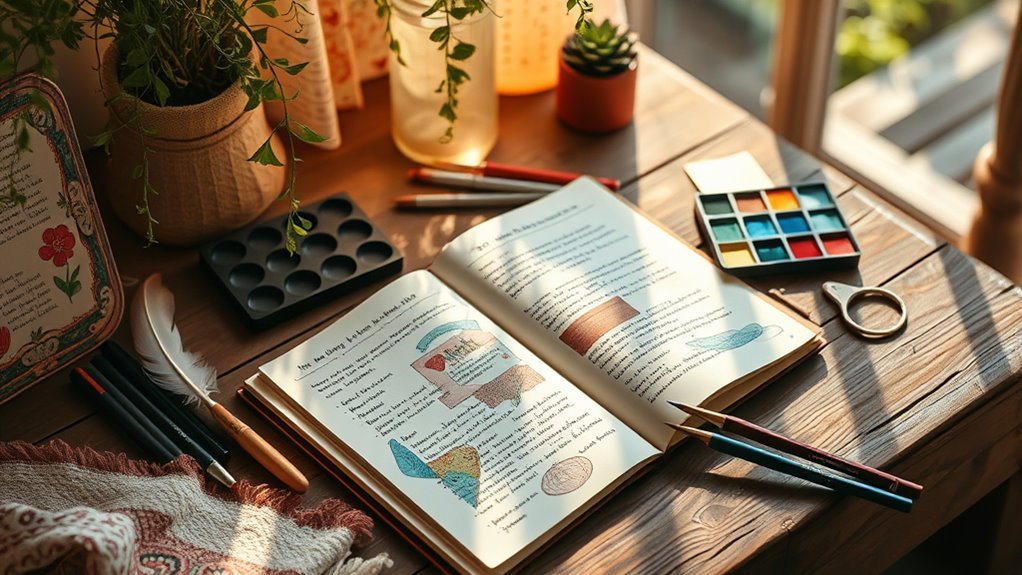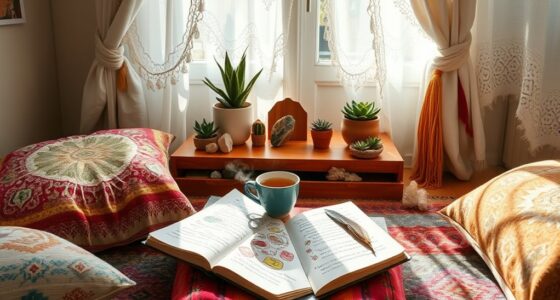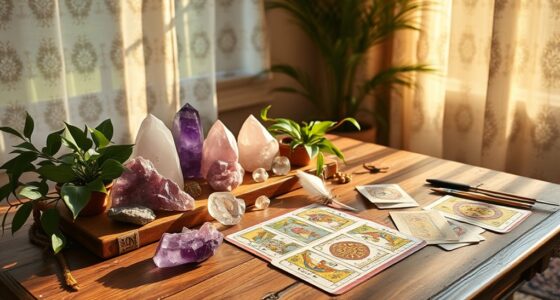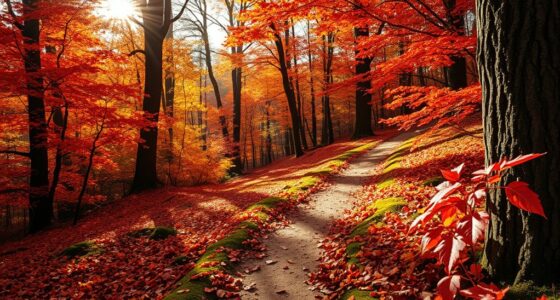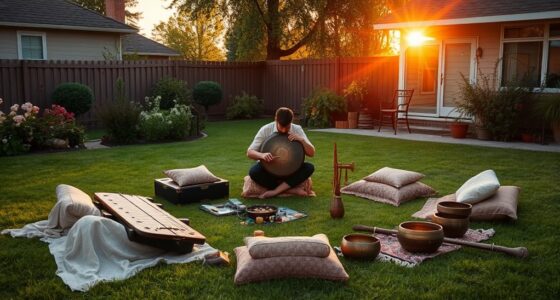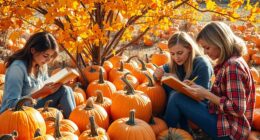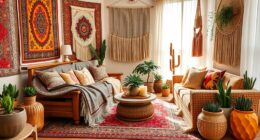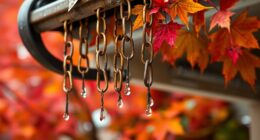Boho journaling is a vibrant, free-spirited way to express your creativity by layering textures, colors, and mixed media into unique visual stories. You can explore various supplies like watercolor, collage, and hand lettering, while incorporating natural elements and personal memorabilia. Embracing imperfections and experimenting with techniques helps develop your signature style. If you want to discover inspiring ideas, innovative techniques, and ways to make your journal truly your own, you’re in the right place to learn more.
Key Takeaways
- Boho journaling emphasizes free-spirited self-expression through layered textures, vintage ephemera, and natural materials.
- Incorporates diverse mediums like watercolor, collage, and hand lettering to foster personal artistic identity.
- Focuses on spontaneity, imperfections, and authentic storytelling to create unique, meaningful art journals.
- Uses natural elements and personal memorabilia to add tactile richness and emotional depth.
- Encourages experimentation with color theory, layering techniques, and mixed media for dynamic visual impact.
Embracing the Boho Style: Free-Spirited Self-Expression
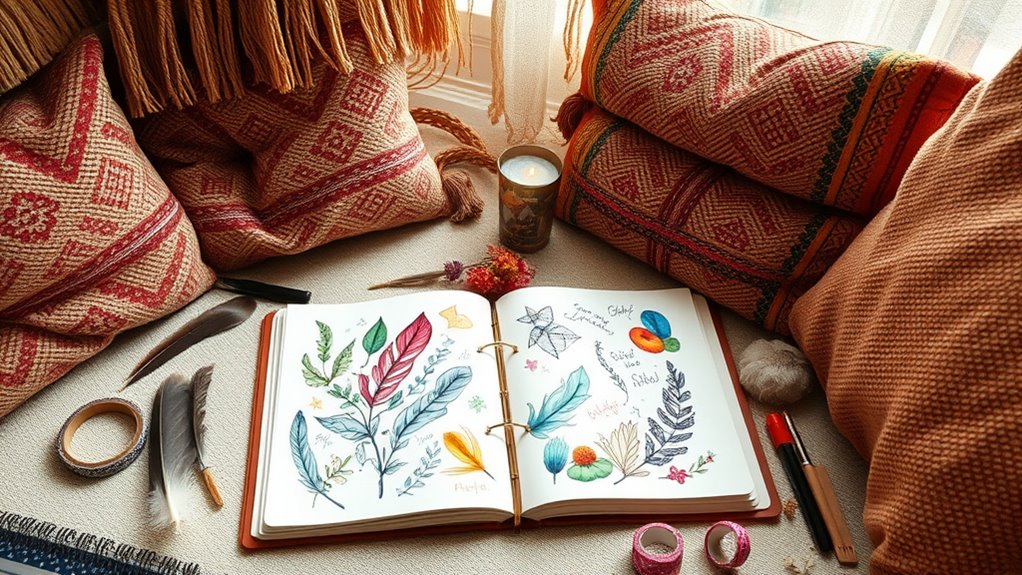
Embracing the boho style means opening yourself up to free-spirited self-expression that celebrates individuality. This eclectic approach encourages you to break away from strict rules and create layouts that reflect your unique personality. With boho journaling, you can experiment freely, layering textures, doodling, and adding natural materials like botanical illustrations or vintage ephemera. The style thrives on spontaneity, so you’re encouraged to incorporate floral patterns, earthy tones, and handcrafted details that evoke a sense of wanderlust and creativity. It’s about expressing yourself authentically and embracing imperfections, allowing your journal to become a reflection of your free spirit. In this relaxed, artistic space, your self-expression takes center stage, making each page a personal, eclectic masterpiece. Additionally, incorporating elements inspired by the WWE Raw’s financial impact can add a unique and contemporary dimension to your art journal, blending entertainment history with your creative expression. Recognizing the essential oils for creative inspiration can further enhance your journaling experience by fostering a calming and motivating environment, especially when considering the importance of precious metal investments for financial stability and diversification. Exploring the benefits of eye patches can also be a soothing addition to your creative routine, helping to refresh your mind and promote focus. Incorporating techniques from textile art such as layering mixed media elements can also deepen the richness of your pages and inspire new creative directions.
Essential Supplies to Kickstart Your Art Journaling Journey
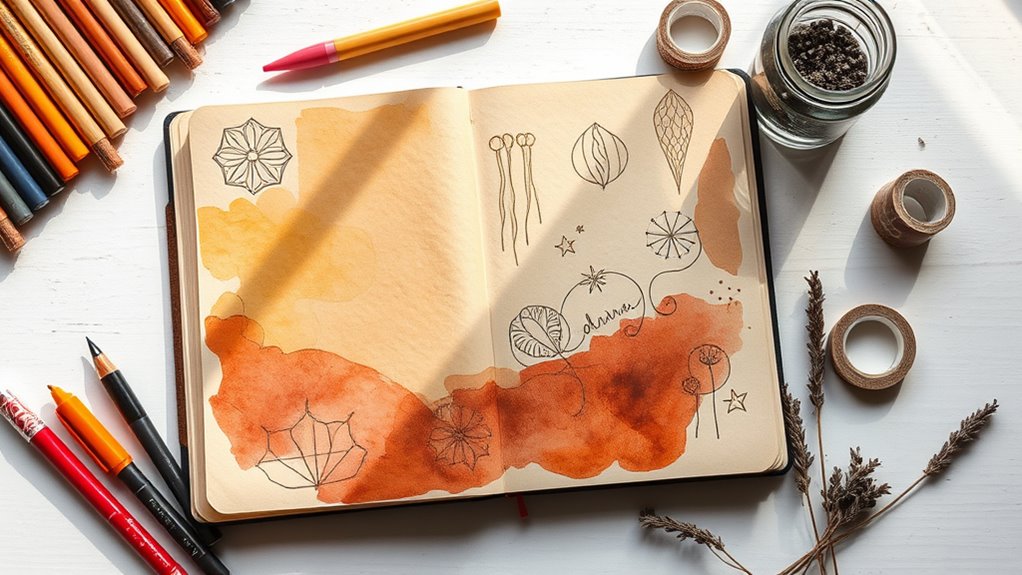
Starting your art journaling adventure requires gathering the right supplies to bring your creative ideas to life. An indispensable first step is choosing a sturdy art journal with thick, durable paper that can handle various mediums without bleeding or tearing. Basic supplies include waterproof pens, watercolors, and acrylic paints for versatile expression. You can find affordable options at dollar stores, using household items like sponges or magazine clippings to add texture. Colored pencils, charcoal, adhesives, and small brushes are also vital for layering, details, and mixed media techniques. For portability, assemble a compact art journaling kit with a small palette, travel-sized adhesives, and brushes, so you can create anywhere. Having quality supplies ensures your art journal becomes a reliable space for your creativity to flourish. Additionally, selecting appropriate paper quality is crucial to maintain the integrity of your artwork over time. Exploring different artistic mediums can expand your expressive possibilities and enhance your creative growth. Understanding art supply organization can help you keep your materials accessible and encourage regular journaling practice.
Exploring Color Theory for Vibrant and Cohesive Pages
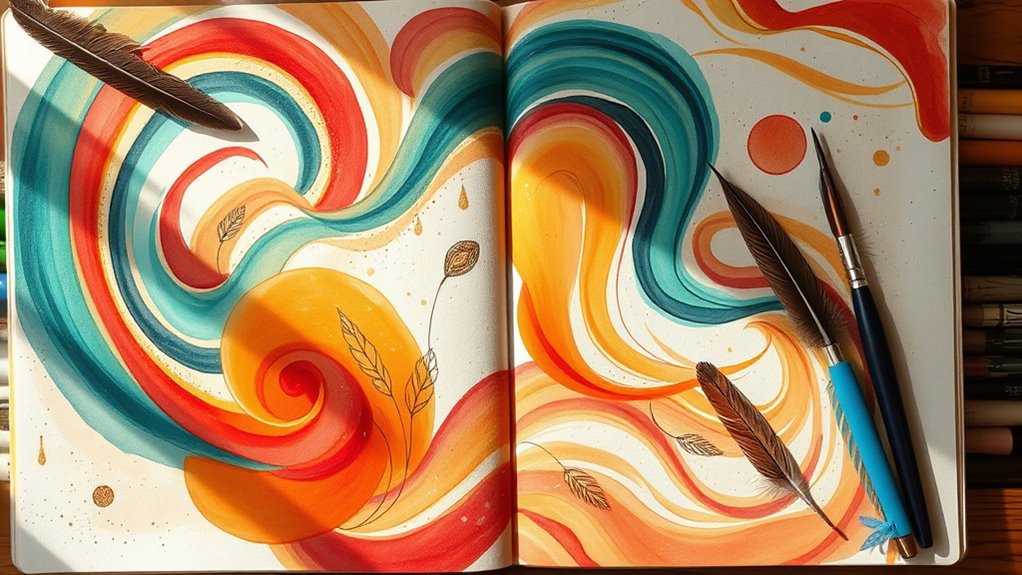
Exploring color theory can transform your art journal pages into vibrant and cohesive works of art. Understanding color harmony helps you select primary, secondary, and tertiary colors that work well together, creating a balanced visual impact. Limiting your palette to 3-4 colors allows you to tell a more intentional color story and avoid chaos. Experiment with color mixing using brushes and sponges to produce unique shades and dynamic effects, adding depth and interest. Using contrast and complementary colors emphasizes key elements and evokes emotion, making your pages more engaging. Applying these principles guides you in setting the mood and elevating your overall aesthetic. Mastering color theory empowers you to craft intentional, eye-catching layouts that resonate with your creative vision. Incorporating color contrast techniques can further enhance visual interest and help your pages stand out.
Techniques for Layering and Creating Visual Depth
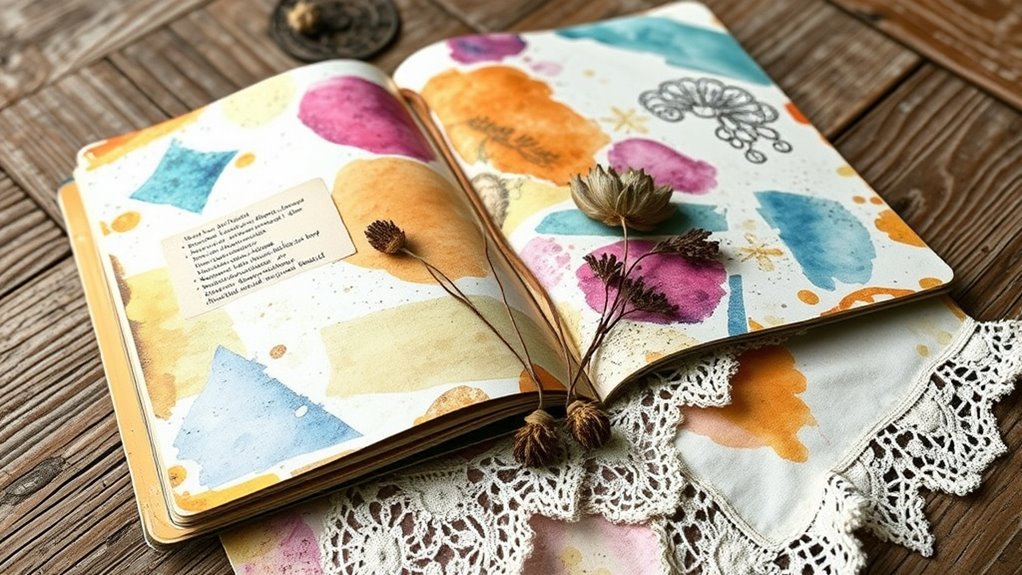
Building visual depth in your art journal pages involves mastering layering techniques that add richness and dimension to your work. By applying multiple materials such as paint, tissue paper, and inks, you create a layered effect that invites viewers to explore your page. Techniques like dry brushing, glazing, and collage enhance textures and deepen the sense of depth. Incorporate tactile elements like fabric or found objects to further enrich your layers. Strategic use of light and shadow through contrasting colors amplifies dimension. Consider this meaning behind your layers:
| Surface | Texture | Purpose |
|---|---|---|
| Paint | Smooth | Base color |
| Tissue | Fragile | Visual interest |
| Fabric | Textured | Tactile contrast |
These layers work together, building a cohesive, multi-dimensional composition. Additionally, understanding visual perception can help you intentionally guide the viewer’s eye through your page, creating a more dynamic and engaging piece. Exploring artistic expression can also inspire new layering techniques and creative ideas to elevate your journal pages. Incorporating color theory can further enhance the harmony and visual impact of your layered artwork. To enhance your understanding of how viewers interpret depth, studying perceptual psychology can provide valuable insights. Developing an awareness of visual illusions can also help you manipulate perception and add surprising effects to your work.
Mixing Media: Unlocking Creativity With Diverse Materials
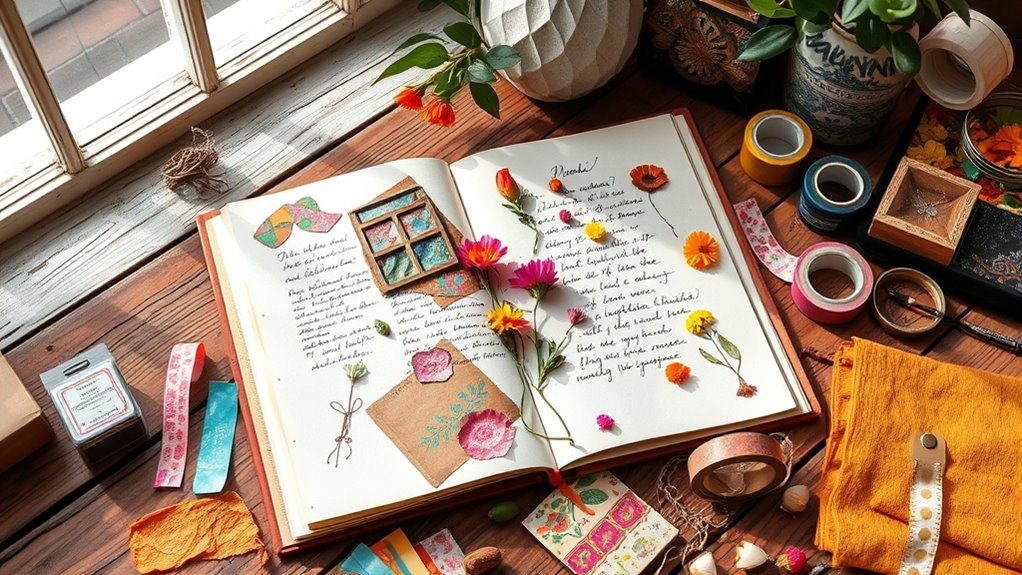
Mixing media opens up endless possibilities for creative expression in your art journal. By combining watercolor, acrylics, ink, collage materials, and found objects, you can craft textured, layered pages that reflect your unique style. Techniques like layering transparent and opaque elements, blending colors, and adding different textures create depth and visual interest. Using diverse materials such as fabric scraps, magazine cutouts, or natural items makes each page more personal and dynamic. Experimenting with mixed media encourages spontaneity, helping you break free from traditional rules and develop a distinctive artistic voice. Incorporating multiple mediums not only enriches your journal’s visual appeal but also enhances emotional storytelling through contrast, harmony, and tactile richness, transforming your art journal into a vibrant creative outlet. Additionally, exploring different art supplies can inspire new techniques and broaden your expressive capabilities. Engaging with mixed media techniques also fosters experimentation, which can lead to unexpected and exciting results in your journaling practice. Exploring artistic experimentation further pushes your boundaries, allowing you to discover unique combinations and styles that reflect your personal journey.
Finding and Developing Your Unique Artistic Voice
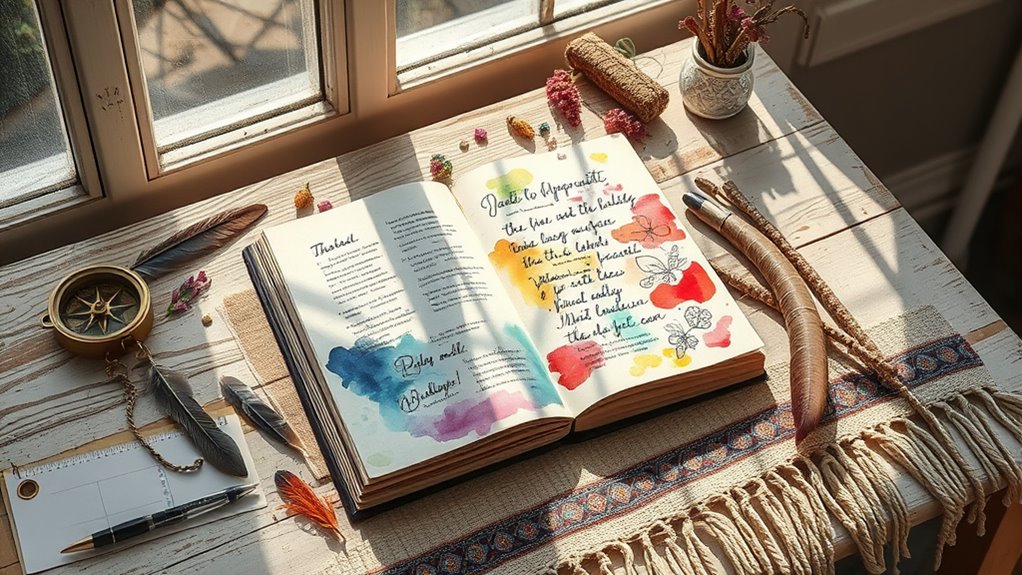
To find your unique artistic voice, start by exploring different mediums like watercolor, collage, or ink to see what feels most authentic to you. Don’t be afraid of making mistakes or imperfections—these often reveal your true style. Regularly reflect on your work to notice recurring themes and techniques that help your personality shine through. Embracing artistic experimentation can lead to discovering new styles that resonate with your inner self. Additionally, experimenting with various artistic techniques can help you understand which methods best express your personal vision. Developing a consistent practice can also enhance your community engagement and provide valuable feedback to refine your style. Being aware of cybersecurity vulnerabilities during your creative process can help protect your digital work from potential threats. Furthermore, understanding the importance of emotional alignment can improve your ability to connect with your audience on a deeper level.
Embrace Personal Style
Finding and developing your unique artistic voice in boho journaling involves exploring different mediums like watercolor, collage, and hand lettering to see what truly resonates with you. To embrace your personal style, consider these steps:
- Experiment with various techniques to discover what feels natural.
- Reflect regularly to identify recurring themes, colors, and methods that define your style.
- Accept mistakes and imperfections—they add authenticity and spontaneity to your work.
- Study different art journaling styles to inspire elements that align with your personality.
- Incorporate skin preparation techniques to ensure your creative workspace remains comfortable and safe throughout your artistic process.
- Additionally, exploring electric bike options can inspire dynamic movement and fresh perspectives for your creative explorations. Incorporating artistic tools like quality brushes and pens can also enhance your work and help solidify your unique style.
Experiment Freely and Often
Experimenting freely and often is essential for discovering your unique artistic voice in boho journaling. By trying different materials, techniques, and themes, you’ll uncover what truly resonates with you. Embracing mistakes as opportunities for growth boosts your confidence and fuels creativity. Maintaining open-mindedness allows you to explore mediums like collage, watercolor, or hand lettering, sparking fresh ideas and new expressions. Regular experimentation reveals patterns and personal preferences that shape your style. Remember, spontaneity nurtures authenticity, so don’t shy away from trying anything new. Use this table to keep track of your exploration:
| Material/Technique | Outcome/Feelings |
|---|---|
| Collage | Inspired visual storytelling |
| Watercolor | Soft, flowing backgrounds |
| Hand lettering | Bold, personalized accents |
| Mixed media | Rich textures and depth |
| Doodles | Playful, spontaneous details |
Reflect and Evolve
As you continue exploring different materials and techniques in your boho journaling, taking time to reflect on your work helps uncover the elements that truly resonate with your creative identity. Reflection reveals patterns like recurring themes, favorite colors, or techniques that define your authentic voice. To deepen this process, consider:
- Reviewing your pages regularly to spot evolving styles
- Acknowledging mistakes as opportunities for growth
- Trying new prompts to challenge your creativity
- Analyzing works of other journalers for inspiration
Overcoming Creative Blocks and Turning Ideas Into Art
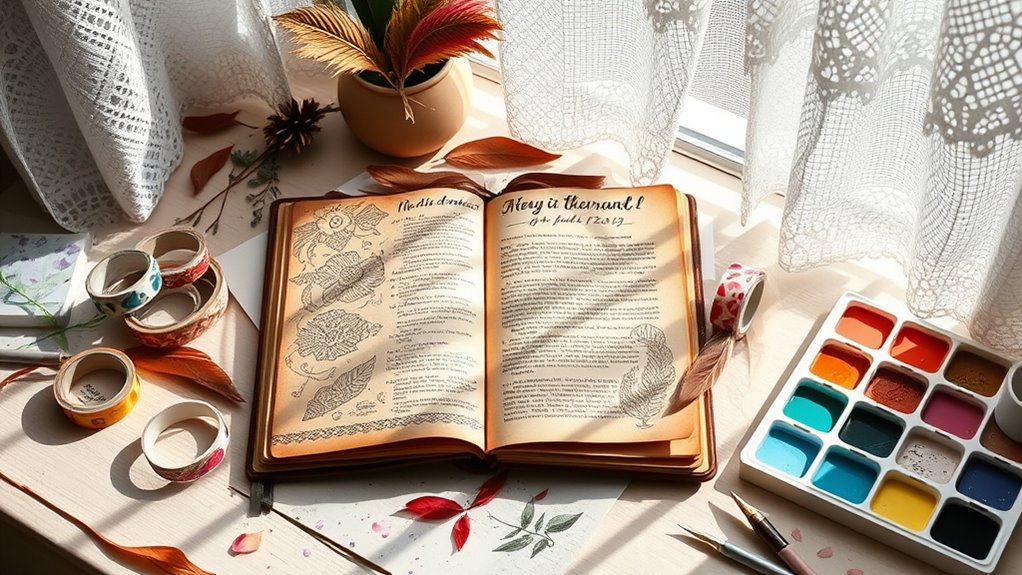
Creative blocks often stem from perfectionism or lack of routine, but establishing a daily art journaling practice can help you break through these barriers. As an art journaler, you’ll find that consistent experimentation sparks fresh ideas and keeps your creativity flowing. Use guided prompts and thematic pages to push beyond familiar techniques, encouraging exploration and discovery. Incorporating diverse materials like fabric, collage, and mixed media stimulates your senses and offers new ways to express your ideas visually. Embrace mistakes as part of the process—spontaneous experimentation can transform perceived failures into unique, inspiring elements. Setting aside dedicated, distraction-free time also helps you develop a habit of turning fleeting ideas into finished art, making creative blocks a thing of the past.
Incorporating Nature and Personal Memorabilia Into Your Journals
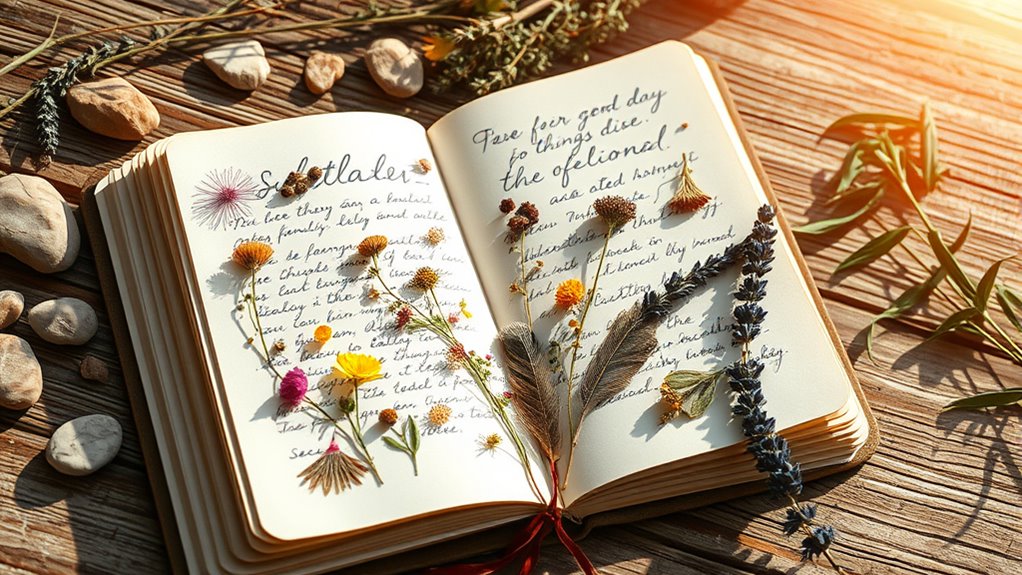
Incorporating natural elements like leaves, flowers, and twigs can add texture and a personal touch to your journals, reflecting your connection to the outdoors. Personal memorabilia such as tickets, postcards, and dried flowers help create meaningful, story-rich layouts. Using pressed botanicals and collage techniques, you can craft layered pages that preserve memories and showcase seasonal changes.
Nature-Inspired Embellishments
Adding natural elements like pressed leaves, flowers, and twigs to your journal pages instantly brings texture and organic beauty to your work. These embellishments connect your art to the world around you, making your journal a reflection of nature’s diversity. To deepen your creative expression, consider these ideas:
- Collect and preserve dried petals, feathers, or small stones to personalize your entries and evoke meaningful memories.
- Create layered collages by blending natural materials with paint, ink, or paper cutouts for tactile richness.
- Use seasonal finds to document environmental changes, highlighting your connection to the outdoors.
- Match color palettes to natural surroundings, such as earthy tones for autumn or vibrant hues for spring, to enhance your themes.
Stop overthinking—let nature inspire your art and make your journaling truly expressive.
Personal Keepsake Integration
Natural elements like pressed leaves, flowers, and twigs can bring a tactile and meaningful dimension to your journal pages. By pressing and preserving these items, you retain their vibrant colors and shapes, adding visual interest and a connection to nature. Incorporate personal memorabilia such as tickets, postcards, or dried flowers to craft rich, storytelling collages that reflect your experiences. Gluing or stitching these items into your journal transforms it into a visual diary filled with authentic memories. Using ephemera from travels or special occasions makes your pages uniquely yours, capturing moments in time. Combining natural objects with personal keepsakes creates one-of-a-kind pages that showcase your journey, deepen your connection to the environment, and make your art journal a cherished reflection of your life.
Frequently Asked Questions
How Can I Personalize My Boho Journal to Reflect My Unique Style?
To personalize your journal, start by choosing colors, patterns, and materials that resonate with you. Incorporate your favorite quotes, photos, or meaningful symbols. Use different textures like fabric, washi tape, or stickers to add depth. Doodle, sketch, or write in your own style to make it uniquely yours. Experiment with layouts and embellishments until it reflects your personality and creative spirit perfectly.
What Are Some Eco-Friendly Materials I Can Use for Journaling?
So, you want eco-friendly materials for journaling? How charming—saving the planet one page at a time! You can use recycled paper or cardboard, biodegradable glues, and plant-based dyes for your covers. Opt for soy-based inks and natural fibers like hemp or organic cotton for your embellishments. Not only will your journal look fabulous, but you’ll also be the eco-warrior everyone secretly wishes they could be—without sacrificing style.
How Do I Preserve and Protect Delicate or Vintage Items in My Journal?
To preserve delicate or vintage items in your journal, handle them with care and use acid-free, archival-quality materials. You can mount fragile pieces with gentle, pH-neutral adhesives or place them in clear, protective sleeves. Avoid direct sunlight and moisture, which can cause deterioration. Store your journal in a cool, dry place. Regularly check your items to guarantee they stay intact, and consider using archival sprays for added protection.
Can Boho Journaling Be Combined With Digital Art Techniques?
Imagine blending watercolor streaks with pixel-perfect digital sketches; that’s what combining boho journaling with digital art techniques offers. You can layer textured papers and vintage ephemera over digital backgrounds, creating a rich, eclectic mix. Digital tools let you experiment freely, add vibrant colors, or tweak designs easily. This fusion sparks endless creativity, letting you craft unique, expressive pages that merge the tactile charm of boho style with the versatility of modern technology.
What Are Beginner-Friendly Ideas for Spontaneous, Free-Form Journaling Pages?
When starting spontaneous, free-form journaling pages, you should keep it simple and loose. Grab your favorite pen or marker, and let your thoughts flow without overthinking. Try doodling, scribbling, or adding random words and shapes as they come to you. Use colors freely, collage snippets, or write stream-of-consciousness. The goal is to enjoy the process and tap into your creativity without judgment or restrictions.
Conclusion
Your boho journaling adventure is like a vibrant garden bursting with colors and textures. Embrace your free spirit, let your creativity flow freely, and watch your pages come alive with personal stories and artistic flair. Remember, every page is a blank canvas waiting for your unique touch—so plunge in, experiment, and let your imagination grow wild. With each stroke and tear, you’re weaving a beautiful tapestry of self-expression that’s truly one of a kind.
